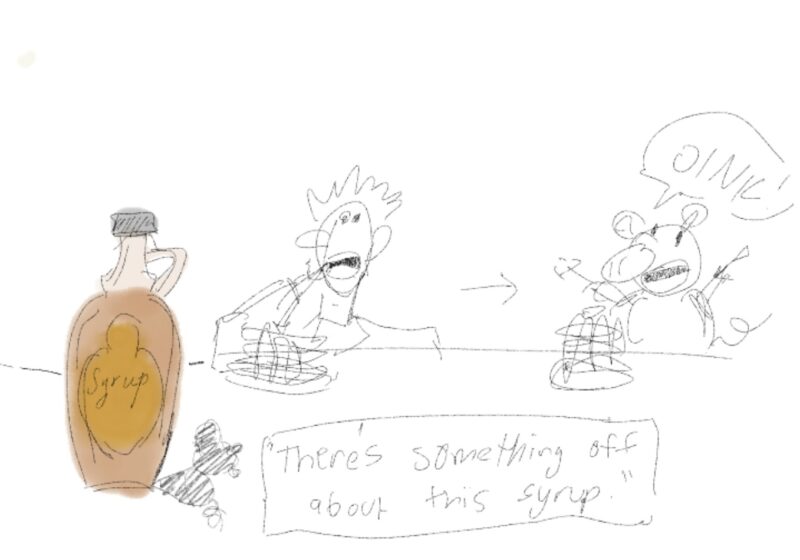“TOOP is following in [Alfred Hitchcock’s] footsteps to transcend monetary restrictions and create an unforgettably rich two-hour adventure,” read a message from The Opposite Of People (TOOP)’s dramaturge, Take Five Scholar Katherine Varga, referring to TOOP’s production of “The 39 Steps.”
Hilariously self-aware, the four-person cast (Juniors Jordan Polycn-Evans and Murie Gillet and sophomores Meredith Watson and Michelle Fonda) kept its audience simultaneously immersed in the story and amused by the tongue-in-cheek acknowledgement of its nature as a low-budget show.
Senior Michael Tamburrino directed the play, which was adapted from the 1935 Alfred Hitchcock film by Patrick Barlow. (The film was based on John Buchan’s 1915 novel.) It tells the tale of Richard Hannay (Polycn-Evans), a bored Englishman who unwittingly gets caught up in a conspiratorial chase to protect a national secret.
The set was made of, among several other things, four construction ladders. The ladders held up two white sheets, which acted as the set’s border and were used throughout as projection surfaces. Upon entering the venue, nothing looked like one might expect. First, there was no definable “backstage.” The actors lounged in clear view before the performance and during intermission, and ladders and sheets don’t exactly scream 1935 London. Waiting for the show to start, this blending of on- and off-stage was the first tribute to performance, as just that—a performance. Tamburrino’s directorial choice to acknowledge the staged elements of the production blended with the captivating plot without taking away from it.
In one scene, Hannay is fleeing from the police, who falsely suspect him of murdering the mysterious, international spy Annabella Schmidt. Mid-pursuit, the actors ran behind the set, and the audience was left to watch a doodled landscape projected onto one of the white sheets. Soon, stick-figure drawings of Hannay and his pursuers, (Fonda and Gillett) came running over a drawing of a bridge. With no where else to turn, stick figure Hannay looked left and right and then jumped off the bridge, descending to the doodled depths below. Kudos to the actors (who conspicuously orchestrated the scene with a classic, middle-school era projector) for impressing so much frantic emotion onto stick-figure Hannay’s decision to jump.
Another crucial set piece was a square, wooden frame, meant to be a window. In many instances, characters in “The 39 Steps” flee through windows. To do so, the actors went through the hilariously-slow process of raising the frame above their heads, bringing it over their bodies and stepping through it.
When Hannay encounters the police on a train, he flees out the window and ends up on the roof. In a massive crowd-pleaser, and one of the most memorable aspects of Barlow’s play, the actors simulated running and leaping across train cars. In the front, Polcyn-Evans ran in place, jumping every so often across what could only have been the gaps between the cars. Fonda and Gillet brought up the rear, jumping shortly after Polcyn-Evans, gaining on him. In what was not the only much-appreciated Hitchcock reference, a stuffed parrot appeared out of nowhere, to which someone shouted, “It’s the birds!”
The performances of all four actors were consistently phenomenal throughout. Polcyn-Evans portrayed the handsome, you’ve-got-the-wrong-guy trope with an endearing humor, forcing the audience to root for him while laughing at the drama of his situation. His opening monologue, which introduces the flashback that is the play (“London. 1935. August. I’d been back three months in the old country and frankly wondering why”), sounded like your typical rainy-night movie opening in a black-and-white bar, with cigar smoke wafting to the ceiling.
Watson’s embodiment of the dramatic, over-exaggerated film-noir female was superb in the roles of the secret-agent Annabella and the innocent, naive Margaret, and her repartee with Polycn-Evans as his very rom-com-esque counterpart, Pamela, was amusing. One scene finds Hannay and Pamela in the room of an inn, handcuffed together and soaking wet. Watson and Polcyn-Evans were on-point with their sideward glances as Pamela takes off her stockings and Hannay’s cuffed hand moves slowly down her leg. Watson delivered some great physical humor as Annabella as well—when she enters Hannay’s living room, stabbed in the back, she falls to his lap. When he tries to move her, she freezes on her side, arms spread-eagle and mouth agape, while he tries to push her off.
The show’s “clowns,” played by Fonda and Gillett, stole the show. Exercising the bulk of the character-switches without an ounce of dwindled energy, Fonda and Gillett successfully executed what is necessary for Barlow’s adaptation of the film: quick costume switches, willingness to improvise (the line between script and improvisation was blurred throughout—unbeknownst to the audience how little or how much) and enthusiastic embodiment of about 100 characters. Their roles as the lovable Mr. and Mrs. McGarrigle were happily sustained while Hannay and Pamela stayed at the McGarrigle hotel. Gillett brought sweet, innocent excitement to the role of the poor Mr. Memory, making him tragically sympathetic as he lay dying in the end.
“I think all theater first and foremost should be entertainment, before anything else,” Tamburino said of his goals for the play. “I just wanted to make people laugh […] I wanted to give people the experience of being in a bigger space than drama house has.” TOOP’s production of “The 39 Steps” was evidently fun for both the audience and the set actors. For a small space, small cast and small budget, the play delivered enormous energy and place. Creative set and costume design, well-timed sound cues and a dedicated performance by not only the cast but the crew made “The 39 Steps” a performance that was, indeed, transcendent.
McAdams is a member of the class of 2017.




